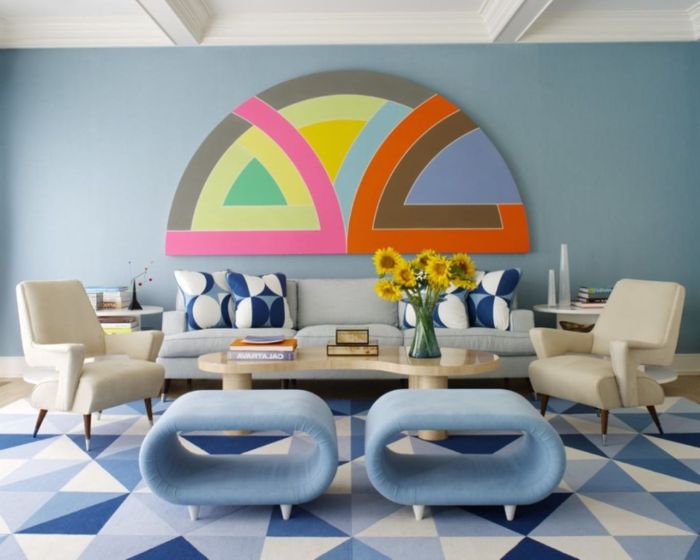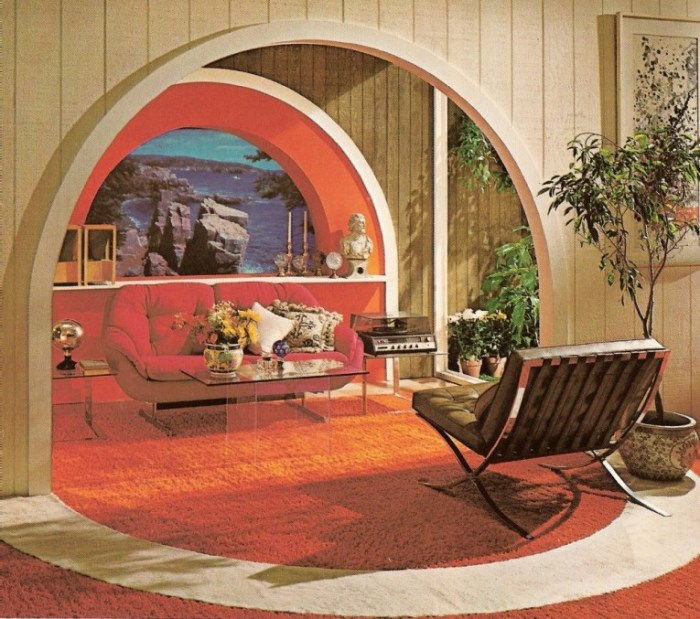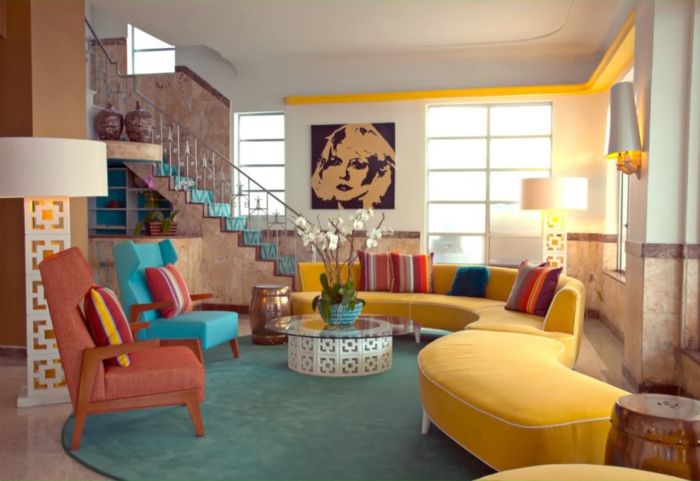Exploring Retro Interior Design: A Nostalgic Journey through Time
Delving into retro interior design, this introduction immerses readers in a unique and compelling narrative. Retro design elements from the past eras of the 1950s, 60s, and 70s come alive through bold patterns, vibrant colors, and iconic furniture pieces. Get ready to discover how to bring a touch of nostalgia into modern interiors with a retro twist.
Definition of Retro Interior Design

Retro interior design refers to a style that takes inspiration from past decades, particularly the 1950s, 60s, and 70s. It is characterized by bold patterns, vibrant colors, and geometric shapes that create a nostalgic and unique aesthetic.
Key Characteristics of Retro Interior Design
- Bold Patterns: Retro design often incorporates bold patterns such as polka dots, stripes, or floral prints to add a playful and vibrant touch to the space.
- Vibrant Colors: Bright and bold colors like mustard yellow, avocado green, and burnt orange are commonly used in retro interiors to create a lively and energetic atmosphere.
- Geometric Shapes: Retro design embraces geometric shapes like circles, squares, and triangles in furniture, wallpaper, and decor to add a sense of whimsy and fun.
Examples of Retro Design Elements
- Avocado Green Kitchen Appliances: A popular trend in the 1970s, avocado green kitchen appliances bring a retro flair to modern kitchens.
- Shag Carpets: Shag carpets with their plush and cozy texture were a staple of retro interior design in the 1960s and 70s.
- Eames Lounge Chair: The iconic Eames Lounge Chair designed in the 1950s is a classic piece of retro furniture known for its sleek lines and comfortable design.
Color Schemes in Retro Interior Design
Color schemes play a crucial role in defining the retro look and feel of interior spaces. Retro interior design often incorporates bold and vibrant colors that were popular in past decades, such as avocado green, mustard yellow, burnt orange, and pastel hues.
These colors are nostalgic and evoke a sense of nostalgia for the mid-20th century.
Common Retro Color Schemes
- Avocado Green: This earthy green tone was a popular choice in the 1960s and 1970s, adding a touch of nature to interiors.
- Mustard Yellow: A warm and inviting color often used in retro design, bringing a sense of coziness and retro charm.
- Burnt Orange: This bold and vibrant hue was a staple in the 1970s, adding a pop of color and energy to interior spaces.
- Pastel Hues: Soft pastel colors like baby blue, mint green, and blush pink were commonly used in the 1950s, creating a light and airy retro aesthetic.
Incorporating Retro Color Schemes into Modern Interiors
To effectively incorporate retro color schemes into modern interiors, consider the following tips:
- Accent Walls: Paint one wall in a retro color to create a focal point in the room without overwhelming the space.
- Furniture and Accessories: Introduce retro colors through furniture pieces, throw pillows, rugs, and artwork to add pops of color throughout the room.
- Color Blocking: Experiment with color blocking techniques by pairing retro colors together in bold and geometric patterns for a fun and dynamic look.
- Balance with Neutrals: Balance out bold retro colors with neutral tones like white, gray, or beige to prevent the space from feeling too overwhelming.
Furniture and Decor in Retro Interior Design
When it comes to retro interior design, furniture and decor play a crucial role in capturing the nostalgic vibe of the era. Iconic pieces such as egg chairs, bubble lamps, and Eames lounges are synonymous with retro style and can instantly transform a space.
Iconic Retro Furniture Pieces
Iconic retro furniture pieces like egg chairs, bubble lamps, and Eames lounges are not only stylish but also serve as statement pieces in retro interior design. These pieces often feature bold colors, unique shapes, and innovative materials that were popular during the mid-20th century.
- Egg Chairs: Designed by Arne Jacobsen in 1958, egg chairs are known for their futuristic look and cozy, enveloping shape. They add a touch of elegance and sophistication to any retro-inspired space.
- Bubble Lamps: Created by George Nelson in the 1950s, bubble lamps are iconic for their sculptural design and soft, diffused light. They are perfect for creating a warm and inviting atmosphere in a retro interior.
- Eames Lounges: Designed by Charles and Ray Eames in 1956, Eames lounges are timeless pieces that blend comfort with style. Their sleek lines and premium materials make them a favorite in retro interior design.
Mixing Retro Furniture with Contemporary Pieces
To achieve a balanced look in retro interior design, it's important to mix retro furniture with contemporary pieces thoughtfully. This juxtaposition of old and new creates a dynamic and visually interesting space.
- Balance: Mix retro furniture with contemporary pieces in a way that maintains harmony and balance in the room. Avoid overcrowding the space with too many retro items.
- Color Coordination: Coordinate the colors of retro and contemporary pieces to create a cohesive look. Choose a color palette that ties the different styles together seamlessly.
- Focal Point: Use a statement retro piece as a focal point in the room and complement it with simpler, modern pieces to enhance its impact.
Sourcing Authentic Retro Pieces or Modern Replicas
When looking for retro furniture pieces, you have the option of sourcing authentic vintage pieces or modern replicas that capture the essence of retro design. Here are some tips for finding the right pieces for your retro interior:
- Antique Stores: Explore antique stores, flea markets, and vintage shops to find authentic retro pieces with character and history.
- Online Retailers: Browse online retailers specializing in retro furniture and decor for a wide selection of authentic pieces and modern replicas.
- Auctions and Estate Sales: Keep an eye out for auctions and estate sales where you can find unique retro pieces at affordable prices.
- Furniture Designers: Look for reputable furniture designers who create modern replicas of iconic retro pieces using high-quality materials and craftsmanship.
Patterns and Textures in Retro Interior Design

When it comes to retro interior design, patterns and textures play a crucial role in creating that nostalgic and funky vibe from the past. Incorporating popular patterns and textures can truly bring a space to life and transport you back in time.
Popular Patterns in Retro Design
- Paisley: This intricate and teardrop-shaped pattern is a staple in retro design, adding a touch of bohemian flair to any space.
- Polka Dots: Fun and playful, polka dots are a classic retro pattern that can instantly liven up a room.
- Psychedelic Prints: Bold and colorful psychedelic prints were a hallmark of the 1960s and 1970s, perfect for adding a groovy touch to your interior.
Incorporating Retro Textures
In retro interior design, textures play a significant role in creating a tactile and visually appealing space. Here are some retro textures you can incorporate:
- Shag Carpets: Nothing screams retro more than a shag carpet. The plush and shaggy texture adds a cozy and nostalgic feel to any room.
- Velvet Upholstery: Luxurious and soft, velvet upholstery was a popular choice in retro design. It adds a touch of elegance and sophistication to furniture pieces.
- Plastic Accents: Retro design often featured plastic accents in bright colors, adding a pop of fun and whimsy to the space.
Importance of Layering Textures and Patterns
Creating a cohesive retro aesthetic involves layering textures and patterns strategically. By mixing different textures like velvet, shag, and plastic accents with patterns like paisley, polka dots, and psychedelic prints, you can achieve a balanced and visually interesting space that truly captures the essence of retro design.
Last Word

In conclusion, retro interior design offers a nostalgic charm that transcends time. By incorporating retro color schemes, iconic furniture, and patterns into your space, you can create a cohesive retro aesthetic that pays homage to the past while remaining relevant in the present.
Dive into the world of retro interior design and let your creativity flow as you design your own retro-inspired space.
FAQ Explained
What defines retro interior design?
Retro interior design is characterized by bold patterns, vibrant colors, and geometric shapes inspired by past eras such as the 1950s, 60s, and 70s.
How can I incorporate retro color schemes into modern interiors?
To effectively incorporate retro color schemes, consider using colors like avocado green, mustard yellow, or burnt orange in accent pieces, walls, or furniture to create a retro look and feel.
Where can I find authentic retro pieces or modern replicas for my space?
You can source authentic retro pieces from vintage stores, flea markets, or online marketplaces. For modern replicas, furniture stores specializing in retro designs or online retailers offer a wide selection.
Why is layering textures and patterns important in retro interior design?
Layering textures and patterns adds depth and visual interest to your space, creating a cohesive retro aesthetic that reflects the eclectic nature of retro design.